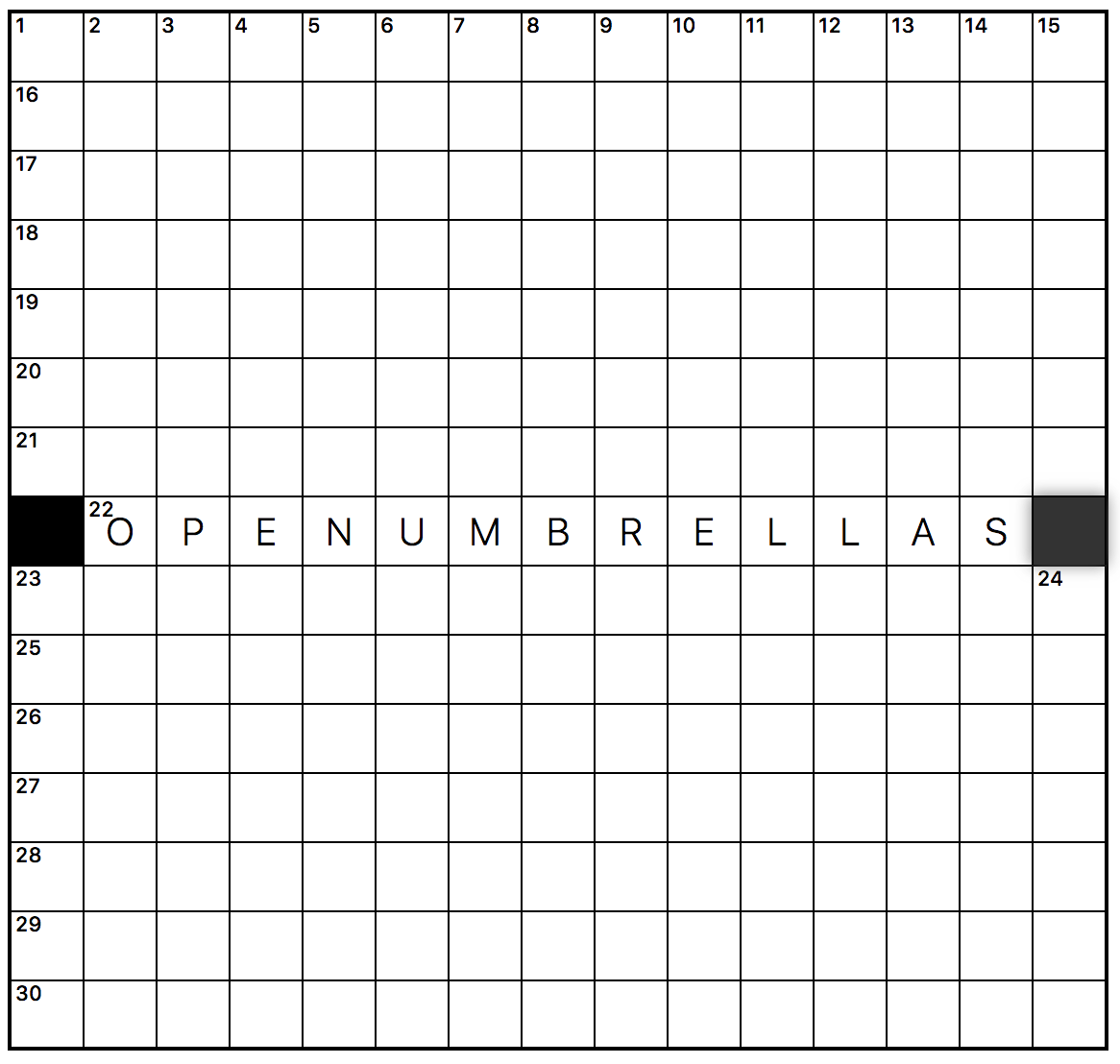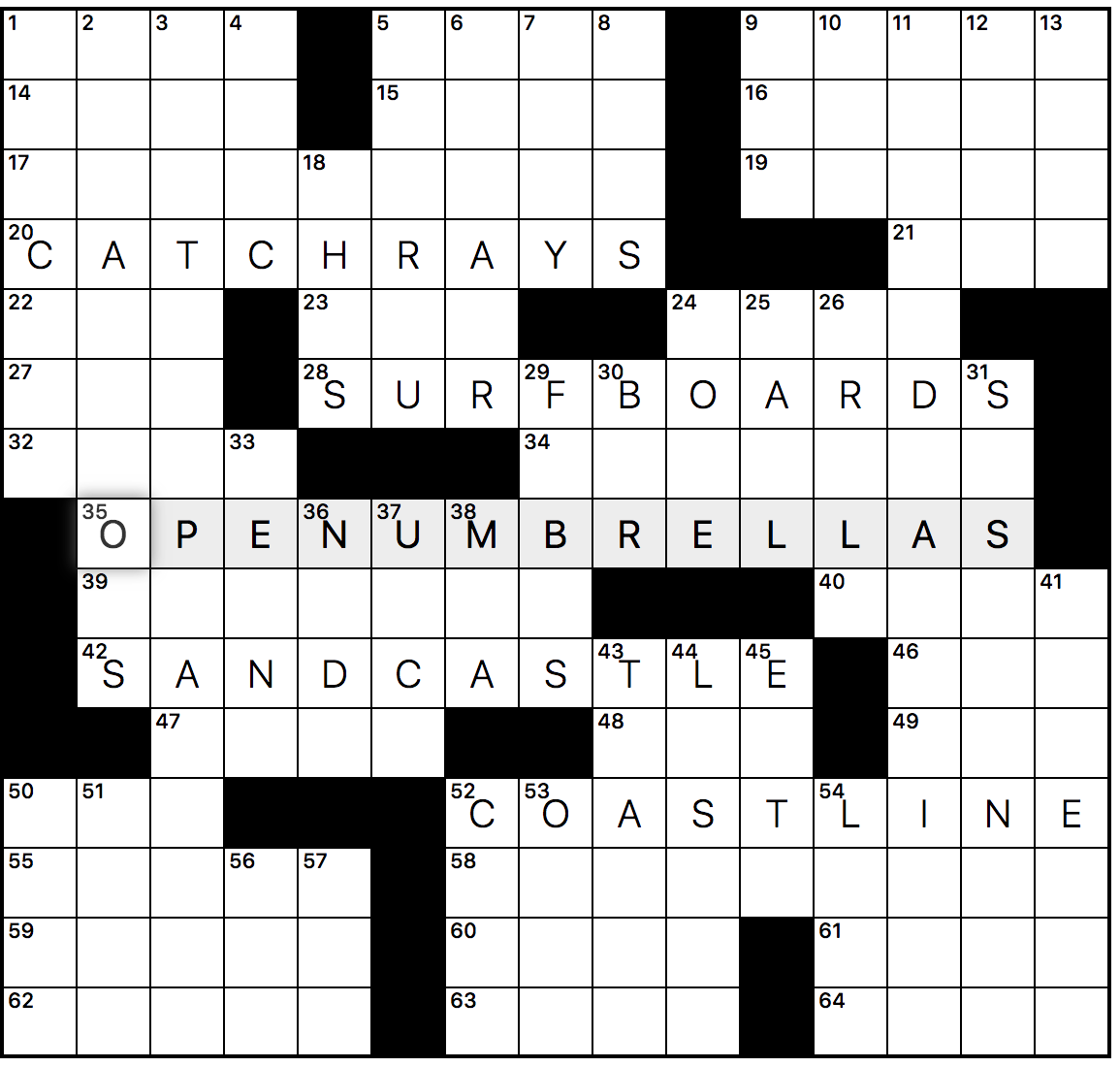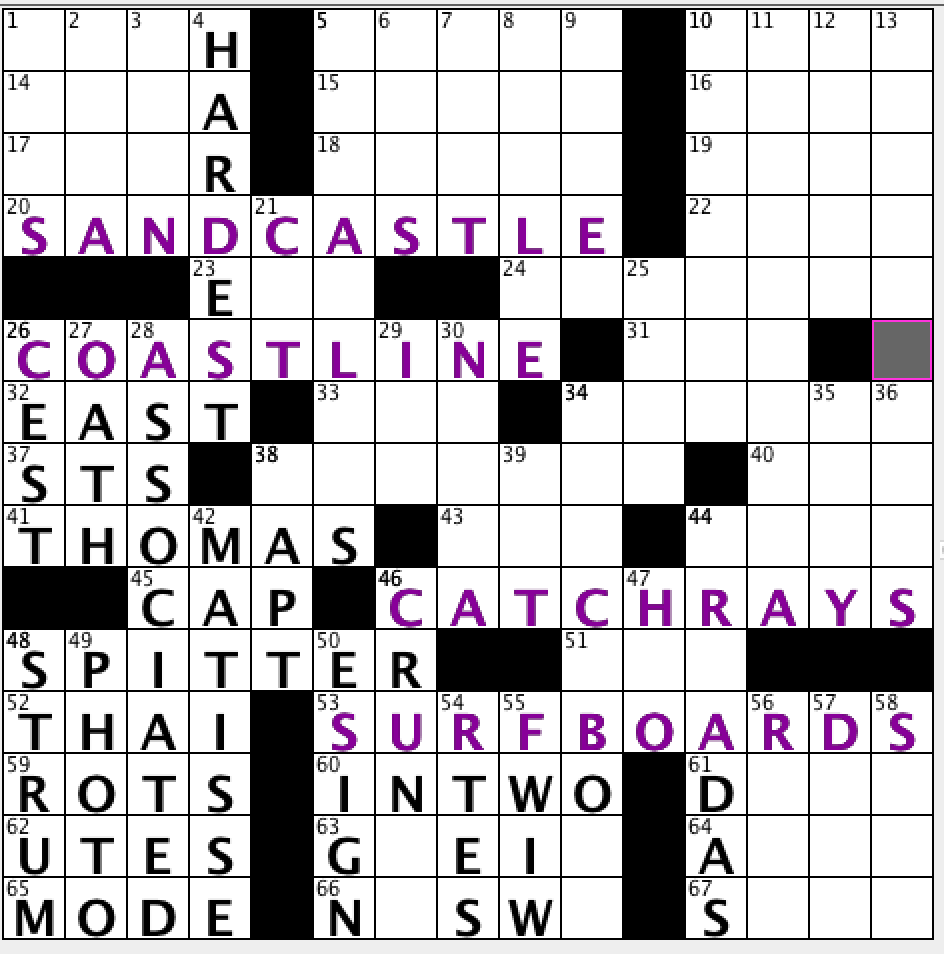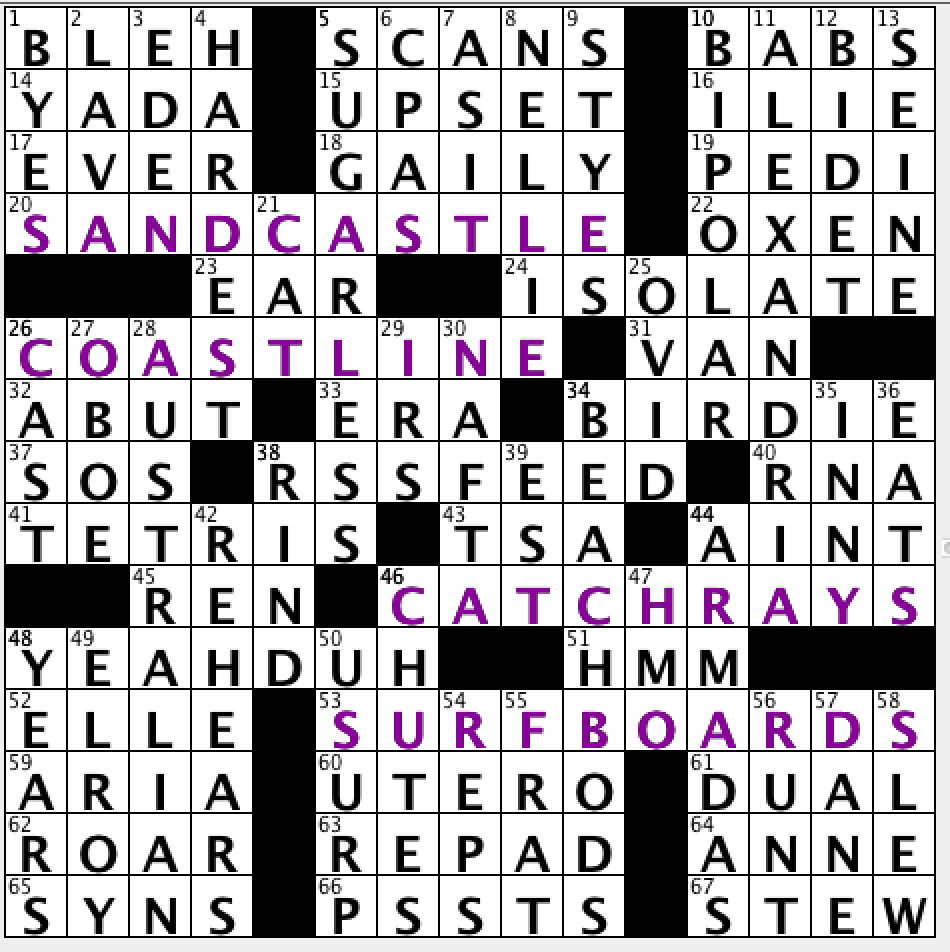My latest hobby is solving crossword puzzles. I’ve been doing the New York Times puzzle daily for the last 8 months or so and absolutely love it. I am constantly impressed and amazed by what the creators of these crosswords can do — build a complete and connected puzzle while still integrating humor, trivia, creativity, and puns.
I’ve been so impressed, in fact, that I decided to give it a go myself. What goes into building — colloquially referred to as “constructing” — a crossword puzzle? Can I do it myself? Can I end up constructing a puzzle that makes its way into the New York Times, the gold standard of crosswords? Let’s find out!
Puzzle Construction Goals
My first step in the process was to set up some guidelines. After completing enough crosswords I learned things that I liked seeing in puzzles and things that I didn’t.
-
No “double whammies” - I never knew what these were called but I would see them occasionally. I call it a double whammy when two clues cross that involve somewhat obscure “trivia” that you either know or you don’t. I’ve since learned this is referred to as a “Natick” in the crossword community. They can be annoying when you’re solving and I wanted my puzzle to avoid them.
-
No “auto-fill” help - Probably the most obvious challenge in constructing a crossword is getting all of the letters (known as the “fill”) to line up and create words in both directions. Perhaps unsurprisingly, there are computer programs that can help build puzzles that have clean fill. I wanted to avoid using these and slog through it the old fashioned way.
-
Clean fill - This is a bit harder to explicitly quantify but I really wanted my puzzle to not have anything too obscure or lucky. After doing a few puzzles you realize that there are many clues that end up being somewhat “convenient” for the constructor. I wanted to make sure every clue of my puzzle was there deliberately and not just there because I got lucky that LEV happens to be the currency of Bulgaria, for example.
-
Have fun - I did this to have fun and to learn - I am not trying to make a career out of crossword constructing. I needed to remind myself of this goal several times throughout the process when I started to get frustrated.
Lastly, before I get into too many details, this post is going to detail my process of constructing an entire puzzle. There will obviously be “spoilers” ahead. If you’d like to solve my puzzle first, you can find it here, in several formats: [AcrossLite] [PDF] [Solution]
The Theme
Most NYT crossword puzzles are centered around some type of “theme.” These themes range from clues that contain colors to Denzel Washington movie quotes and even to “rebuses” - boxes that can contain more than one letter or a non-letter. Virtually all constructors agree that the first step to building a themed puzzle is to come up with your theme idea and the theme clues. Theme clues tend to be the longest answers in a puzzle and thus are the hardest to place, so you want to get them out of the way first.
I actually started down this constructing journey while I was sitting on the beach during my Babymoon in Hawaii. And being a California boy, a beach theme seemed appropriate. Looking around for inspiration, I saw a happy little kiddo building a sand castle and wondered whether I could incorporate that into my puzzle. SANDCASTLE is 10 letters long, a reasonable length for a theme clue, and also has some alternate meanings. SAND can be a verb, and CASTLE can refer to a chess piece. Maybe I could make this work.
 The beach where the construction inspiration struck
The beach where the construction inspiration struck
Theme clues need to be consistent across the puzzle, so I started trying to come up with other two-word beach-related clues that could have alternate meanings. I ended up jotting down 5 total theme clues, knowing I would probably only use 3 or 4, that met these criteria.
-
SANDCASTLE (10 letters) - could also refer to sanding down a chess piece
-
CATCHRAYS (9 letters) - could also refer to catching baseballs from Tampa Bay Rays players
-
OPENUMBRELLAS (13 letters) - could also refer to opening up umbrella insurance policies
-
SURFBOARDS (10 letters) - could also refer to surfing the web and browsing message boards
-
COASTLINE (9 letters) - could also refer to coasting on a bike on a straight line
I also may need to have a “theme revealer” in my puzzle. A theme revealer is a clue that tends to be towards the bottom right of a puzzle that ties together all of the theme entries. For mine, a simple revealer of BEACH (5) (“Locale of the clues of this puzzle”) would probably suffice.
I also thought it’d be fun to incorporate BABYMOON (8 letters) into my puzzle if I could make it work, given the fun-ness of the term and its relevance to my puzzle. We’ll see…
The Grid
Now that I had my theme clues it was time to start laying out the structure of the puzzle. The grid basically refers to the placement of the black squares in the crossword puzzle. That ends up defining word lengths for every answer and where the theme answers will go as well.
I didn’t think this would be that difficult of a task but it ended up being one of the hardest parts of the entire process. What you have to know before doing this is that there are a few simple rules about a “valid” crossword grid:
-
Diagonal Symmetry - All (or almost all) crosswords are symmetric across the diagonal - this means if you put a black square in the top-left corner, one has to go in the bottom-right corner as well.
-
No 1 or 2 letter words - The minimum word length for an answer is 3 letters - seems obvious, right? This ends up being trickier than you’d think because a lot of times you want to terminate a word going across but that causes a 1 or 2 letter word going down.
-
No more than 78 words - Tossing black squares all over the place makes a bunch of short words, that’s a no-no.
-
Grid connectivity - The entire grid must be connected, you can’t close off one section from another.
Tools
This seems like a good time to discuss the tools I used for constructing this sucker. I started off drawing by hand. That lasted about 5 minutes before I realized how many times I’d be erasing. I then moved on to Google Sheets but was getting frustrated with formatting and dealing with symmetry. I then found a cool free tool online called Phil. This kept track of symmetry for me and would also let me fill my clues in later. I ended up using Phil for most of the grid construction phase but ultimately sprung for CrossFire - a full-featured app that has a bunch of features including auto-fill (which I won’t use—see rule #2 above!), word counts, and output formats. If you’re serious about constructing I recommend using a comprehensive tool like CrossFire or Crossword Compiler - it makes your life so much easier.
Due to the symmetric constraints, it’s imperative to have symmetric theme entries too. Fortunately, two sets of my theme entries had the same number of letters. SANDCASTLE and SURFBOARDS both with 10, CATCHRAYS and COASTLINE both with 9.
Biting off more than I could chew
I also had a 5th theme entry of OPENUMBRELLAS which had 13 letters and no partner. I started off trying to include this, but since there’s no clue to use symmetrically, it had to go in the center of my grid. However, since it’s 13 letters, and the grid is 15 letters wide, that forces 1 black square on each side of it.

This was already looking weird with those two black squares. I tried to cram my other theme entries into the puzzle but it got crowded quickly and it was quite difficult (at least for a rookie like me) to create a good grid. I ended up getting them all to kind of fit and adhere to the rules with the following setup.

I was so excited once it all actually fit and validated but then I quickly started noticing a lot of problems. First of all, I had two 15-letter words I would going to have to work in there now (3-D and 11-D). Not only did that seem difficult, but your theme entries should also typically be the longest words in your puzzle. There are also some other patterns that would undoubtedly prove to be problematic later — the 6-letter word ending in U at 5-D — two 10-letter words that will have to fit between a 15-letter and a 7-letter word at 2-D and 31-D. Plus it was just kind of an ugly grid overall.
I spent at least 3 hours trying to work this grid — it was way more difficult than I imagined it would be. As painful as it was, I ended up scrapping it and starting over, this time not expecting to get my OPENUMBRELLAS clue in the puzzle.
Round 2
Starting over on the grid felt like a step backward but it was much smoother the second time through. At first, I was really trying to work a BEACH revealer in there too, but wasn’t having much luck. Adding any kind of 5 letter word into a grid where your theme answers are 9 and 10 letters long ended up being a big challenge. Just like the umbrella clue, I abandoned the idea of trying to get BEACH in there…for now at least…
I did end up moving my theme answers to be more on top of each other—this prevented me from having a lot of long words which I figured would make my life easier in the future. After about 30 minutes I ended up with this grid that I think will work well enough.
 Grid is complete!
Grid is complete!
The Fill
Now that the grid was ready came the “fun” part—completing the rest of the letters of the puzzle so that everything is a word. Constructors call this the “fill” because it fills in the rest of the puzzle. There are a few rules about the fill, of course. I have my personal goals like no Naticks and common knowledge only. There is also no profanity allowed and no duplicate clues either.
This was the step that I assumed would be the hardest part of the entire process. I was quite correct in that assumption. Within the first few minutes I realized I was in for quite the challenge.
The longest remaining words in my puzzle are the two 10-letter words at 11-D and 28-D. I figured I’d start there so I started tackling the left-center and bottom-left sections first. I didn’t really know exactly where to start so I just looked up 10 letter words starting with A (since it goes under COASTLINE). There is, unsurprisingly, a lot of them.
I tried to choose words that were fun or would let me be creative with the clues. My method was pretty much to try to plug a word in, fill in around it until I got stuck, and then start over. This took a while and got pretty demoralizing. I was also only doing this by hand right now, no tools or word lists involved yet. I needed a better strategy.
Word Lists
I would often encounter a situation like the following: I need a 5 letter word that ends in A, starts with a vowel, and has a consonant as the 2nd to last letter. Fortunately, my knowledge of grep, a simple command-line tool to parse text with regular expressions, and a local dictionary file with all of the English words helped a bit. The problem with this approach though was that I would ignore any proper nouns (OBAMA), abbreviations (ASPCA), or compound words (UPONA). This is quite a large list to be ignoring. I needed to find a list of all possible words for a crossword - to Google I went!
It turned out I wasn’t the only constructor with this problem. There’s actually a whole economy of fellow crossword constructors selling their word lists. They even “score” the word lists so you can prioritize better/more fun words over other less common words. I wasn’t ready to spring for a premium word list quite yet, but it did make me realize that if you wanted to be a serious constructor, the word list you work off of is probably the most important tool in your toolbox.
If you want to use any of these scored word lists though then you’ll need some robust crossword construction software. As I mentioned earlier, I ended up downloading a Mac app called CrossFire. They offer a free trial that includes a word list as well as some cool lookup features. It ended up working great for me so I shelled out the 50 smackers to get the full version which lets you save progress and work for more than 1 hour.
I also stumbled across an amazing website called XWordInfo which contains a premium word list maintained by legendary constructor Jeff Chen. His clue lookup tool along with my dictionary grepping and CrossFire word list would get me on my way.
Fill Progress
I ended up getting the left-center and bottom-left sections filled in, working off the (kind of lame) word ASSOCIATED, so I moved on to the bottom-center. Then I got completely stuck. I tried and tried and tried to work clues in there but couldn’t ever get anything to fit.

I had sunk hours into getting that bottom left section to work, so going back and redoing it sounded dreadful, but I didn’t think I had any other choice.
After erasing and trying out some other options I had a bit of a breakthrough. I had been relying pretty heavily on words that existed in my word lists and in previous puzzles. There is no rule that says a word has to have existed before though—creativity is allowed! I ended up using YEAHDUH (7) going across the top of the bottom-left section. This is an NYT debut word and a fun one that could be clued with something like “Sarcastic response from a teenager.” It wasn’t easy, but after about 30-40 more minutes I had a fill on the bottom-center that worked with the whole left side. Success!
I also had a realization midway through working that bottom section. I had left out my BEACH revealer clue but there was a way for me to work in a related revealer at 34-D with something like BEACHBALL or BEACHBAGS. I ended up going with BEACHBODS, a fun clue that is also an NYT debut. I could clue with something like “Physiques seen at the locale of the themed clues of this puzzle.” Things were starting to come together!
I’m not sure if it was coincidence or if I was just getting better at navigating the word lists, but the rest of the puzzle filled in a lot smoother than the bottom left. I would never describe it as easy, but I didn’t have any major regressions or problems. After a few more hours of grepping, Googling, searching, filling, and crying, I had a complete fill.

The Clues
The last step in the crossword construction process is writing the clues. This is a pretty fun step and is where the constructor’s creativity really gets to shine. In order to properly write the clues though, you have to know what level of difficulty you are expecting your puzzle to be. For example, the word APPLE could be clued as “iPhone Maker” for an easy puzzle but clued as “Jobs creation” for a harder puzzle.
To decide what difficulty you want your puzzle to be it’s important to understand the general levels of difficulty of the publisher you are submitting to. For the New York Times, 15x15 themed puzzles (like mine) run on Monday through Thursday, with Mondays being the easiest and Thursdays being the hardest. Thursday puzzles also tend to involve a bit more trickery in the theme with things like rebuses or missing letters. You definitely get a feel for it the longer you do the crosswords, but this theme that I had constructed felt like a Monday or Tuesday theme. Ultimately it’s up to the editors which day a puzzle will run, but I would try to clue my puzzle to be a hard-Monday to an easy-Tuesday difficulty.
Realistically when you’re working on the fill you are coming up with some clue ideas in your head as you go. Therefore, this process went pretty quickly. Like the other steps though, there are a few rules about the clues. Again the obvious ones apply such as no profanity or obscure knowledge. The most interesting rule though is that none of your clues can have any of the words from your puzzle or other clues in them. In other words, a word may not appear more than once in a puzzle or its clues.
Looking up how answers have been clued in previous puzzles was extremely helpful for this step. Almost too helpful honestly. With tools like XWordInfo, I could see every way that a word had been clued in the past. This ended up making me realize that previous constructors and editors had found much more interesting ways to write clues than I had. I tried to avoid copying old clues as much as I could and rather used them as inspiration for an interesting way to write a clue.
For example, seeing EAR clued as “It may pop on a plane” led me to try to use the fact that an ear can pop in my clue. I ended up going with “Poppable body part.”
Writing the clues was really fun. Especially letting them sit for a few days and sleeping on some of them for a while. I won’t list all of them out here but here are a few of my favorites:
-
“Anti-liquid agcy.” (TSA)
-
“Sub-par” (BIRDIE)
-
“Like kangaroos and platypuses” (AUSTRALIAN - a (surprising) NYT debut in the Shortz-era)
-
“Source of sin” (EDEN)
-
“Kids take them down from Ladders” (CHUTES)
Final Adjustments
I sent the completed puzzle to a few friends and family members who do crosswords on a regular basis. They gave me great feedback about the sections they liked and the clues that they thought were a stretch. One area, in particular, stood out in many of the responses - the bottom-left. Specifically the crossing of NENA (German pop star) and ELEVE (French word for student). I think I knew deep down that this was a Natick and violated my rule of no double-whammies. This section had given me so much trouble that I tried to ignore it, but after a few people brought it up, I knew I had to change it. Another painful erasure of clues, but it ended up not being too tricky to fix and not impacting other sections too much.
I also received some common feedback that the clue for INNY (Concave navel) was actually spelled INNIE. Another one that I knew was a bit of a stretch but couldn’t find a better fill over in that section. I ended up re-cluing INNY as “In New York” with “What Buff. and Brkln. have in common.” This is still a stretch and not the best clue, but it’s better than a misspelling.
After my last tweaks, I was left with my final puzzle:
 All done!
All done!
Publishing
Now that the clues were written and the puzzle was finished up it was time to submit for publishing! The CrossFire app makes it super easy to conform to the NYT submission guidelines, which (for some reason) still require hard-copy submissions. I printed out my PDF puzzle and mailed it over, along with a huge sense of accomplishment. Then the waiting game began.
Due to most of the publishers’ rules, once a puzzle is accepted the publisher owns the full rights to it. As a result, you can’t just submit your puzzle to as many publishers as you want and see which one replies first. I waited for a few months and eventually got back the following reply from the NYT editing crew, via email.
Thanks for sending us your SURFBOARDS 15x. This theme idea was nice, but the puns weren’t exciting Will quite enough to say yes. Sorry! We appreciated the chance to take a look here, though.
Drats! They didn’t like it. After reading some other message board posts from people who have published many puzzles, I learned that this response basically meant the theme wasn’t interesting enough for them, so there’s pretty much no chance of fixing it. Starting over is a better option than repairing.
After the NYT rejection came through I also submitted the puzzle to another publisher, the Universal Crossword. Their editor, David Steinberg, got back to me more quickly (about 6 weeks later) with a similar response:
Anyway, what an impressive first construction! I especially got a chuckle out of the reparsed SURFBOARDS and COASTLINE. The other two don’t grab me quite as much, though—in SAND CASTLE, I wish the meaning of “sand” changed as well; as for CATCH RAYS, the clue feels a little stretchy to me. While I’m afraid this one is a near miss for me, I hope you’ll try again with another puzzle!
Womp! 0 for 2. At this point, I started to come to terms with the fact that this puzzle wouldn’t make it into a major publication. However, the silver lining is that I still own the rights to it and can share the details with you all!
Lessons Learned
What a fun process this was! While I didn’t officially time it, the full construction process took several weeks. I’d estimate about 40 or 50 hours total. And I now have even more appreciation and respect for the people who do this for a living. Here are a few takeaways about what goes into constructing a puzzle:
-
It’s all about the word list - Having a thorough and complete word list is so so important. Especially if you want to be churning out puzzles at a decent pace. I can’t imagine coming up with a good, clean fill without one.
-
The grid is tough - Building the grid seems like an easy task but it is quite challenging. A bad grid can also set you up for a lot of trouble and headache down the road.
-
Undoing is ok - It was so painful to undo a bunch of work or erase a completed section, especially when said section took hours to begin with. But whenever I did undo a section, the next time through was a lot easier and I ended up being happy with it in the end.
-
Trust your gut - If a clue or word feels iffy or like a stretch, it probably is.
-
Take notes - I took tons of notes on different sections, wrote down which words worked, which words almost worked, why words didn’t work, etc. That ended up being very useful when working on a tough section.
I’m already working on my next puzzle and can’t wait to share it with you all when it’s done — hopefully this time it will be an NYT crossword link!